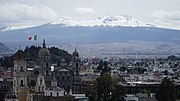Celsius is a small lunar impact crater that is located in the rugged terrain in the southern hemisphere on the Moon's near side. It is named after Swedish...
5 KB (368 words) - 04:36, 19 April 2023
Celsius, the inventor of the Celsius temperature scale, belongs Celsius (comics), a DC Comics superhero Celsius (crater), a lunar crater 4169 Celsius...
1 KB (192 words) - 15:40, 20 March 2024
the northwest, Lindenau to the east, Rabbi Levi in the southeast, and Celsius to the southwest. It is named after Jewish Spanish astronomer and rabbi...
6 KB (367 words) - 09:48, 5 June 2024
Mount Erebus (redirect from Side Crater)
around 1.3 million years and has a long-lived lava lake in its inner summit crater that has been present since at least the early 1970s. On 28 November, 1979...
40 KB (5,674 words) - 15:59, 14 September 2024
Timeline of Opportunity (redirect from Argo (crater))
started in Eagle crater in 2004, literally landing inside on the crater basin, then it travelled outward making its way to Endurance crater. After this it...
172 KB (15,261 words) - 07:18, 3 September 2024
the crater and the person the crater is named for. Where a crater formation has associated satellite craters, these are detailed on the main crater description...
65 KB (73 words) - 17:24, 3 December 2023
frequently overcast summers with average July temperature less than 16 degrees Celsius (60.8 degrees Fahrenheit) 3. Infrequent forest fires/wildfires and fires...
41 KB (3,699 words) - 13:56, 1 September 2024
Hellas Planitia (category Impact craters on Mars)
of the planet Mars. Hellas is the third- or fourth-largest known impact crater in the Solar System. The basin floor is about 7,152 m (23,465 ft) deep,...
20 KB (1,981 words) - 08:40, 27 July 2024
The following is a list of people whose names were given to craters of the Moon. The list of approved names in the Gazetteer of Planetary Nomenclature...
21 KB (1,900 words) - 17:53, 31 May 2024
Garni is an impact crater on Mars, in which, according to NASA, there is evidence of liquid water. In the press release of its finding on 28 September...
5 KB (493 words) - 13:38, 20 May 2024
cones on the southeastern side. Mount Michael has a lava lake in its summit crater, which is fumarolically active, and there is widespread evidence of recent...
26 KB (2,981 words) - 11:58, 11 September 2024
located at the center of the springs boils at roughly 212 Fahrenheit (100 Celsius) creating large plumes of steam. The water coming out of the spring is...
5 KB (455 words) - 09:51, 21 June 2023
generally found in mountainous areas (i.e. alpine lakes), dormant volcanic craters, rift zones and areas with ongoing glaciation. Other lakes are found in...
81 KB (9,645 words) - 12:03, 1 September 2024
Hiroshima and Nagasaki. A 2016 drilling project into the peak ring of the crater strongly supported the hypothesis, and confirmed various matters that had...
21 KB (2,437 words) - 17:52, 6 June 2024
never rises above about 100 K (about −170 ° Celsius), and any water that eventually ended up in these craters could remain frozen and stable for extremely...
59 KB (6,626 words) - 11:38, 14 September 2024
the climatic cooling in 536 and afterwards. A problem is that no impact crater for a meteorite has been found, even though the land area and sea beds have...
12 KB (1,334 words) - 17:55, 2 September 2024
Enceladus (section Impact craters)
Enceladus has a wide variety of surface features, ranging from old, heavily cratered regions to young, tectonically deformed terrain. Enceladus was discovered...
154 KB (14,861 words) - 13:07, 26 August 2024
effect Venus has a temperature of 900 degrees Fahrenheit (475 degrees Celsius), hot enough to melt lead. It is the hottest planet in the Solar System...
47 KB (5,439 words) - 18:17, 14 September 2024
the harsh Ethiopian desert and was lowered 60 ft (18 m) into the smoking crater of the active Erta Ale volcano. He spent a half hour filming on top of the...
7 KB (753 words) - 23:59, 2 September 2024
southernmost lunar landing, until IM-1 landed further southwards in Malapert A crater on 22 February 2024. The lander was not built to withstand the cold temperatures...
90 KB (7,015 words) - 17:28, 11 September 2024
had to endure a temperature range from −50 degrees celsius and as high as more than 150 degrees celsius. India launched the Chandrayaan-1 spacecraft using...
18 KB (1,688 words) - 12:49, 28 May 2024
fire, temperatures easily exceeded 1,000 degrees Fahrenheit [540 degrees Celsius]. Lethal clouds of carbon monoxide and other gases swirled through the...
34 KB (3,992 words) - 15:18, 11 September 2024
He developed the Rankine scale, a Fahrenheit-based equivalent to the Celsius-based Kelvin scale of temperature. Rankine developed a complete theory...
22 KB (2,554 words) - 15:59, 2 September 2024
temperatures ranging between 6 and 25 degrees Celsius during spring and summer, and from −5 to 20 degrees Celsius in winter. Its climate is temperate subhumid...
62 KB (6,990 words) - 04:02, 7 September 2024
at the outlet of Melita Lake, an expansion of Crater Creek which flows west into the Tseax River. Crater Creek gets its name from being in association...
40 KB (4,766 words) - 21:19, 12 September 2024
'Clausius' (symbol: Cl) for entropy. 1 Clausius (Cl) = 1 calorie/degree Celsius (cal/°C) = 4.1868 joules per kelvin (J/K) The landmark 1865 paper in which...
17 KB (1,683 words) - 08:54, 13 September 2024
thermodynamic temperature scale. This corresponds to −273.15 °C on the Celsius scale, −459.67 °F on the Fahrenheit scale, and 0.00 °R on the Rankine scale...
29 KB (3,320 words) - 01:04, 26 August 2024
Three Sisters (Oregon) (category Volcanic crater lakes)
Temperature extremes reach 80 to 90 degrees Fahrenheit (27 to 32 degrees Celsius) in summers and −20 to −30 °F (−29 to −34 °C) during the winters. The Three...
57 KB (6,297 words) - 06:27, 25 August 2024
of Earth’s value) with a temperature generally below zero down to -60 Celsius. The average surface pressure is about 610 pascals (0.088 psi) which is...
145 KB (14,887 words) - 01:06, 3 September 2024



























